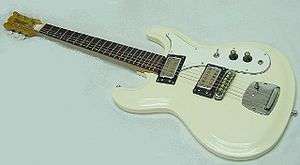Univox
For Univox portable keyboards, see Vox (musical equipment)
| Private | |
| Industry | Musical instruments |
| Founded | 1960 |
| Founder | Thomas Walter Jennings |
| Defunct | 1987 |
| Headquarters | Westbury, New York, United States |
Area served | Global |
| Products |
Electric & acoustic guitars Bass guitars Amplifiers Electronic Keyboards Effects units |
| Parent | Korg |
| Website | VintageUnivox.com (archive site) |
Univox was a musical instrument brand of Unicord Corporation since early-1960s when they purchased the Amplifier Corporation of America of Westbury, New York and began to market a line of guitar amplifiers. Univox also distributed the guitars by Matsumoku (Hi-Flier, 'Lectra, etc.), effects units by Shin-Ei Companion (Super-Fuzz, Uni-Vibe, etc.), and synthesizers by Crumar (Stringman, etc.) and Korg (MiniKorg K1/K2, MaxiKorg K3, etc.).
In 1985, Unicord Corporation was purchased by Korg, and Univox brand was discontinued due to a fire at the Matsumoku factory in 1987.
History
In the early 1960s the Unicord Corporation, a manufacturer of electronic transformers, purchased the Amplifier Corporation of America of Westbury, New York. They began marketing a line of amplifiers under the name of "Univox". The company was purchased by Gulf+Western in 1967. Guitar making operations moved to Japan in 1975 where they continued making guitars until 1982. Production under the Univox name was halted after a fire at the Matsumoku factory. After this time instruments were made in Korea under the name "Westbury". The Unicord Corporation was purchased by Korg in 1985, effectively ending the line for good.
Univox was best known for making copies of instruments from better-known companies such as Mosrite, Fender, Gibson, Rickenbacker, Ampeg/Dan Armstrong, Epiphone and others. These copies are often referred to as lawsuit copies among collectors. The Univox Hi-Flier was largely based on the Mosrite Ventures guitar; it was popularized in the early 1990s by Kurt Cobain, almost two decades after original production had stopped.
Change from "Univox" brand to "Stage" brand
Per Frank Kosinsky, Unicord's Chief Engineer in the late 1970s, as told to Rick Reinckens, a short-term employee, the brand name developed a market reputation as "cheap" because Unicord copied designs from companies like Shure and Electro-Voice instead of doing major original research and development. However, Univox used time-proven electronic circuits and quality components. To avoid this market perception, Unicord developed the Stage brand. However, the only difference between Univox and Stage equipment was the nameplate, attached prior to shipping.
Relationship to Marshall and Korg
Unicord was also the U.S. distributor for both Marshall amplifiers and Korg synthesizers.
Per Rick Reinckens, who worked as a test technician at Unicord including testing Marshall amps coming in from England for sale in the United States, the English Marshalls used EL-34's output tubes. However, per Frank Kozinski, those could barely reach the rated output wattage. So Unicord would replace the tubes with KT-88 tubes before shipping them to U.S. vendors. Kozinski also told Reinckens that Unicord had started out as a manufacturer of electrical transformers. When the original Marshalls came to the U.S., Unicord's engineers were concerned that the output transformers could not reliably handle the full output. Unicord redesigned the output transformers and told Marshall to use the Unicord design in all units shipped to the U.S. and Marshall could use the design outside the U.S. if they wanted to. Marshall did adopt the Unicord design for all their tube amps.
Also, Tony Frank, the design engineer at Unicord, designed the dual-volume-control two-stage pre-amp that Marshall introduced with their 4140 and 2150 amplifiers, which allowed a "super-dirty" fuzz even at extremely low volumes. When the first production units came into Unicord from Marshall, Frank told Reinckens he was the one who had come up with that design.
Products
Univox Amplifiers


A number of tube and solid state amplifiers were produced by Univox over the years. These ranged from small practice combo amps to powerful heads with separate cabinets. Some models had built-in spring reverb and tremolo effects. In 1971 Univox introduced the "B Group" amplifiers, covered in two-toned blue or gray Tolex with distinctive ovalesque cosmetics.[1] These amps were used by The Jeff Beck Group and Led Zeppelin.[2]
Univox Guitars
Around 1967, Unicord merged with Merson, an importer of various headstock-brand guitars such as Tempo, Giannini and Hagström. This new company was called "Merson Musical Products, A Division of Unicord Incorporated, A Gulf + Western Systems Company." Around 1968 they started producing the Univox guitars. In 1975 Unicord and Merson split. However, Unicord continued to make Univox guitars until around 1978, even adding some newer models.[3]
Electric guitars


- Badazz
- Coily
- Custom
- Custom 335 (6 and 12 string versions)[4]
- Deluxe
- Eagle
- Effie (6 and 12 string versions)[4]
- Gimmie
- HR-2
- Hi-Flier
- Limited Edition Series
- Lucy
- Mother/Rhythm and Blues
- Pro (Jazzbix)
- Ripper
- UC-2
- UC-3
- Westbury Performer
Bass guitars
- Badazz
- Coily
- Hi-Flier
- Naked
- Precisely
- Professional
- Stereo
- UB-1
- 'Lectra
Acoustic guitars
- Auditorium
- Artist Series
- Dove
- 'Grass
Univox Keyboards
.jpg)
- Univox K4
- Univox MaxiKorg K3
- Univox MiniKorg K1/K2
- Univox Stringman (see "link". . Archived from the original on 2010-12-19.)
Univox Effects
%2C_Jimi_Hendrix%2C_EMP_Museum_(clean).jpg)
Univox had many effects, but perhaps their most well-known was the Super-Fuzz Pedal, used by Pete Townshend.[3] As of 2009, Univox Super-Fuzz pedals are selling in the $400 – $500 range. Univox also produced the Uni-Vibe, a Leslie speaker effect popularized by Jimi Hendrix.
References
- ↑ "Univox Amplifiers". VintageUnivox.com.
- ↑ "Whole Lotta Led".
- 1 2 "The Univox Page". VintageUnivox.com.
- 1 2 Wright, Michael. "Univox Guitars - Merson/Unicord Part 1". Vintage Guitar magazine (February 1998).
External links
| Wikimedia Commons has media related to Univox. |
- VintageUnivox.com (moved from Univox.org in 2014)
- "Lawsuit" copies discussion
- Matsumoku: Guitars Made in Japan